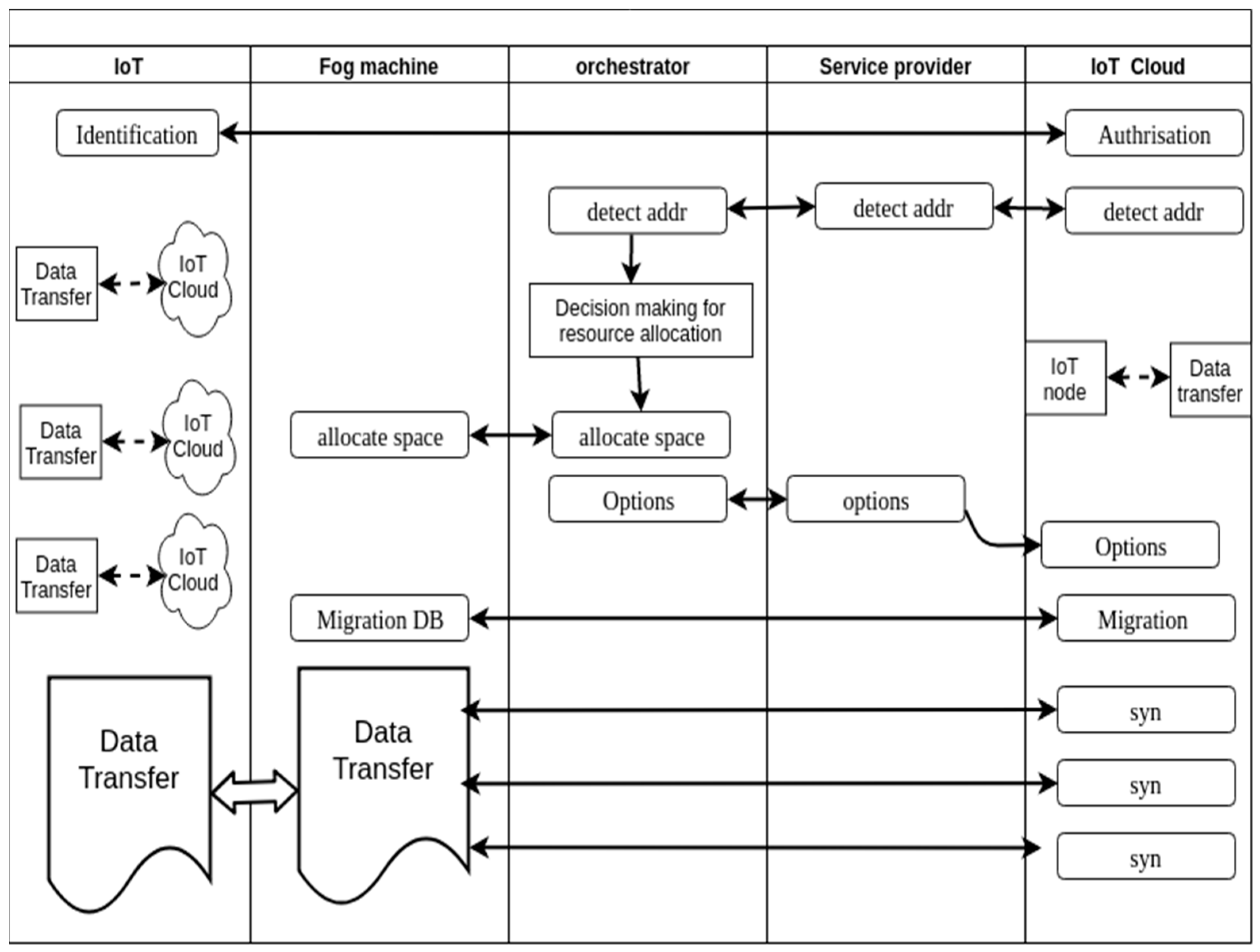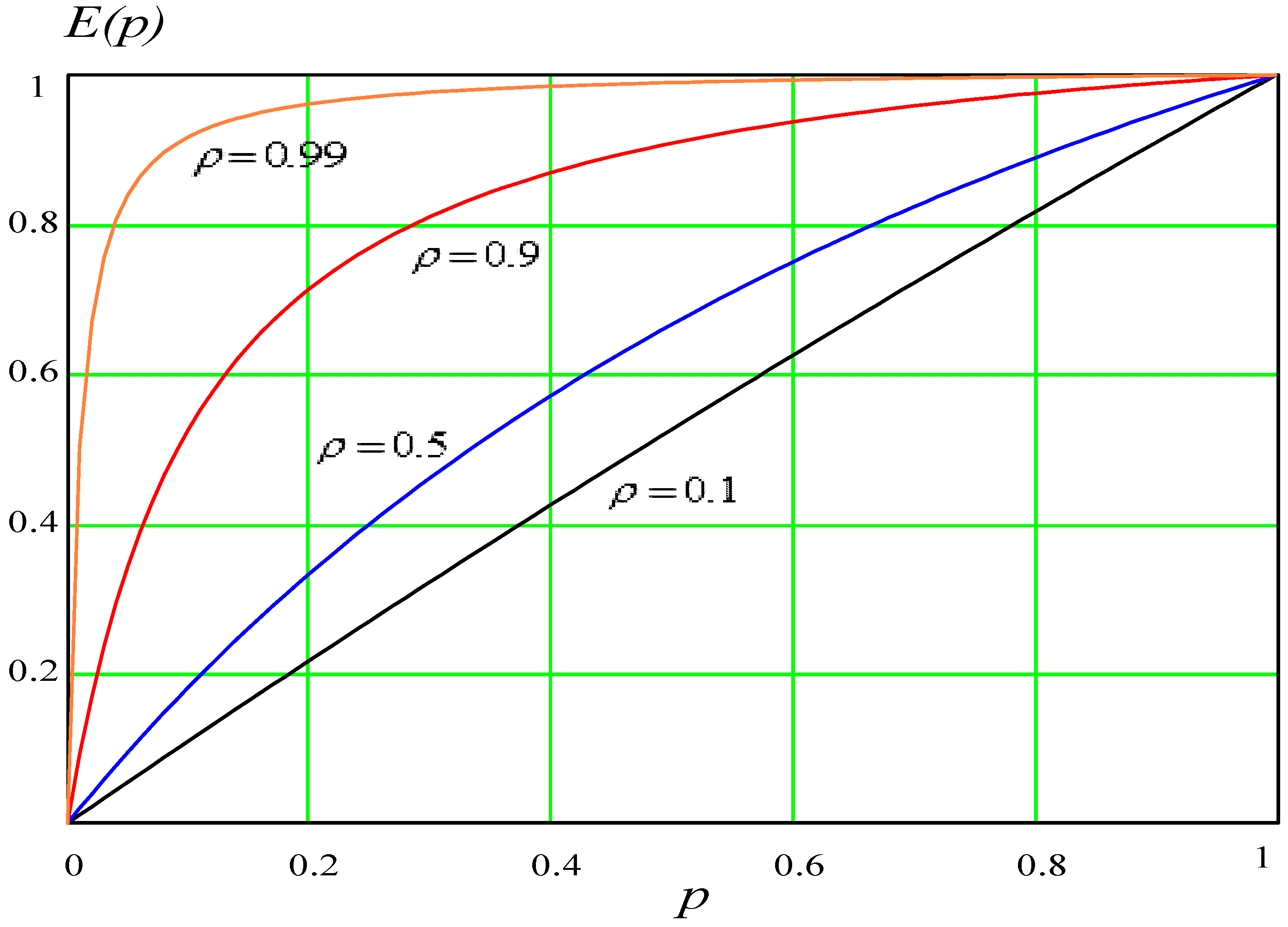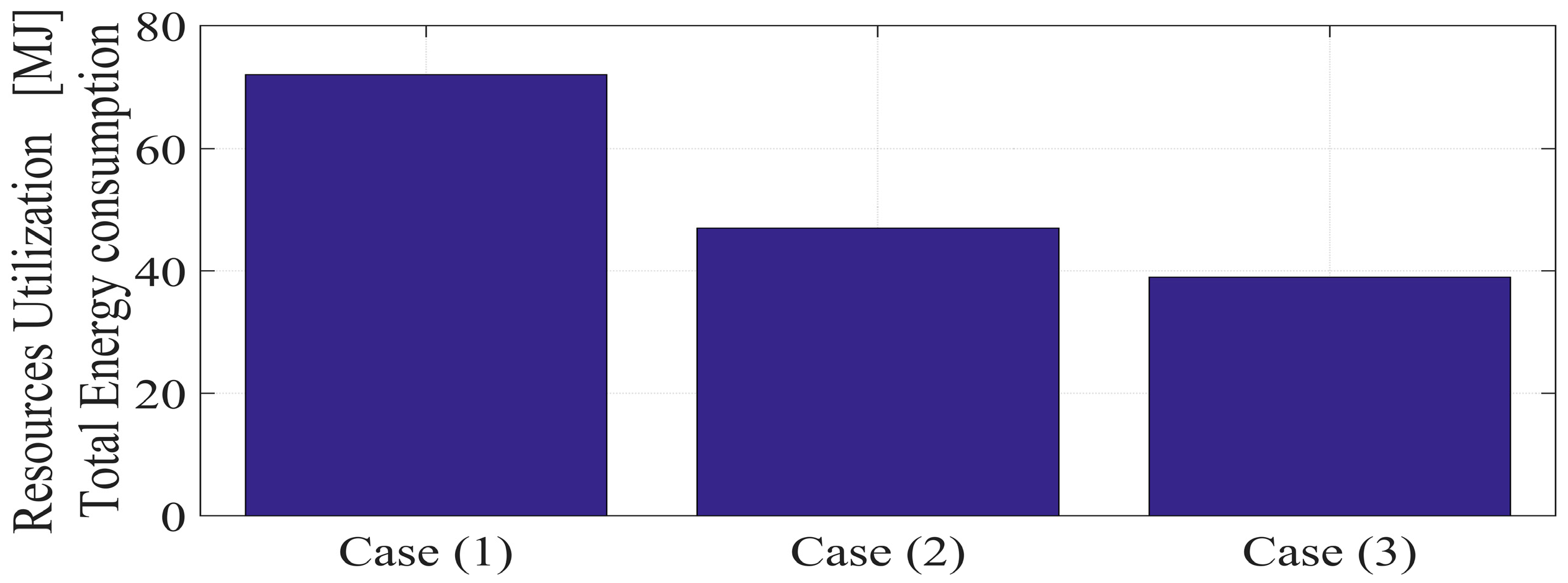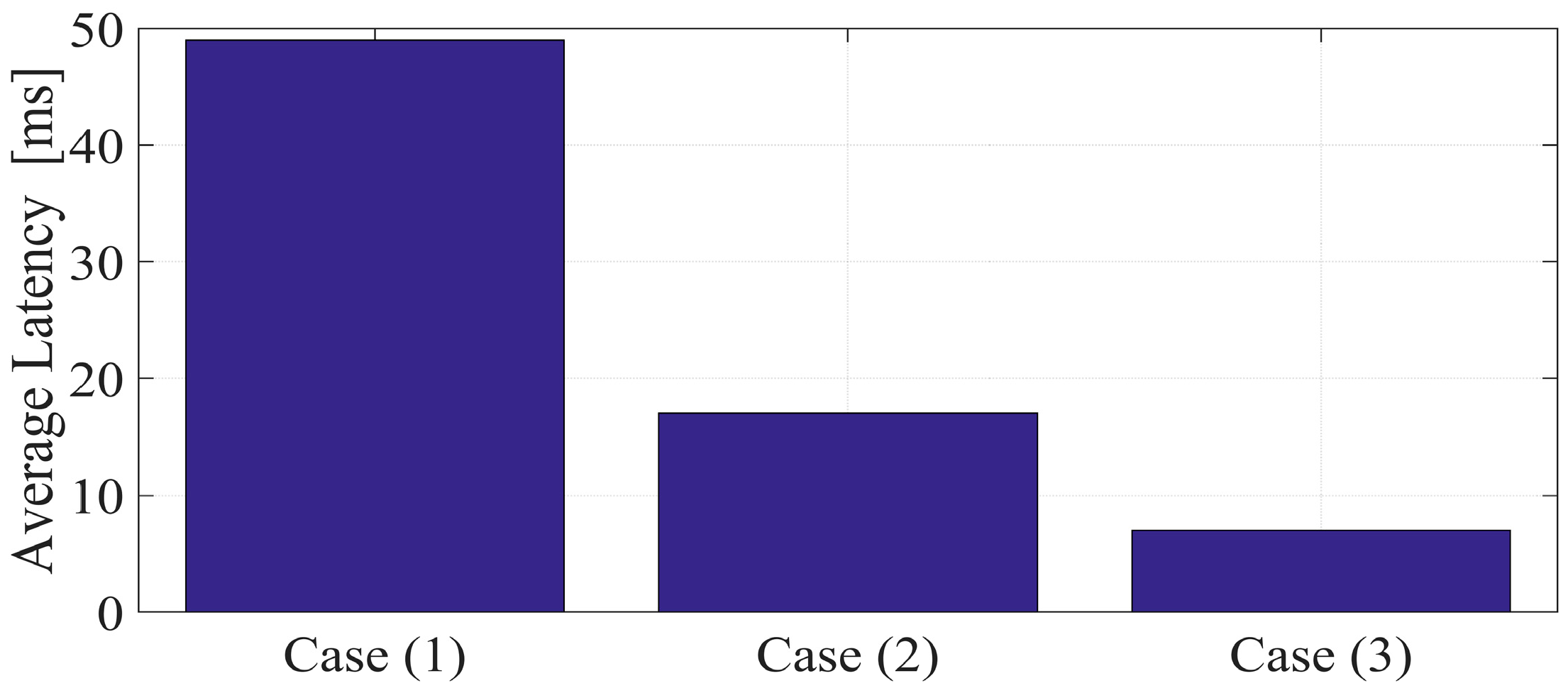Secure and Reliable IoT Networks Using Fog Computing with Software-Defined Networking and Blockchain
Abstract
1. Introduction
- Network coverage,
- High system reliability,
- Security and privacy,
- Integration with other existing communication networks,
- Traffic load, and
- Latency constraints for some applications.
2. Background and Related Works
3. IoT System Structure with Distributed Fog Computing and SDN
3.1. System Structure
3.1.1. SDN Operation and Integration
3.1.2. Blockchain Operation
3.2. Data Offloading Algorithm
- As the system mainly considers resource utilization, it makes use of all the available resources. Consequently, the SDN controller allows the OF switches to handle some processing and computing tasks for the IoT forwarded data after the Fog level. The SDN controller estimates the OF switches with the available resources upon checking certain parameters. These parameters are the following:
- IoT traffic,
- Transit traffic,
- Traffic access type,
- Time delay constraints,
- Processing power for servicing the IoT data, and
- The current state of the OF switches in terms of traffic and resources.
- Reduction of communication latency,
- Channel load reduction,
- Useful for anti-persistence traffic in the core network, and
- Efficient resource utilization.
3.3. Traffic Model
4. Performance Evaluation
4.1. Experiment Setup
4.2. Experimental Results
4.3. Experimental Results
5. Conclusions
Author Contributions
Funding
Conflicts of Interest
References
- Iannacci, J. Internet of things (IoT); internet of everything (IoE); tactile internet; 5G–A (not so evanescent) unifying vision empowered by EH-MEMS (energy harvesting MEMS) and RF-MEMS (radio frequency MEMS). Sens. Actuators A Phys. 2018, 272, 187–197. [Google Scholar] [CrossRef]
- Stojkoska, B.L.R.; Trivodaliev, K.V. A review of Internet of Things for smart home: Challenges and solutions. J. Clean. Prod. 2017, 140, 1454–1464. [Google Scholar] [CrossRef]
- Abuarqoub, A.; Abusaimeh, H.; Hammoudeh, M.; Uliyan, D.; Abu-Hashem, M.A.; Murad, S.; Al-Jarrah, M.; Al-Fayez, F. A survey on internet of things enabled smart campus applications. In Proceedings of the International Conference on Future Networks and Distributed Systems, Cambridge, UK, 19–20 July 2017. [Google Scholar]
- Sethi, P.; Sarangi, S.R. Internet of things: Architectures, protocols, and applications. J. Electr. Comput. Eng. 2017, 2017, 9324035. [Google Scholar] [CrossRef]
- Al-Fuqaha, A.; Guizani, M.; Mohammadi, M.; Aledhari, M.; Ayyash, M. Internet of things: A survey on enabling technologies, protocols, and applications. IEEE Commun. Surv. Tutor. 2015, 17, 2347–2376. [Google Scholar] [CrossRef]
- Farhan, L.; Kharel, R.; Kaiwartya, O.; Hammoudeh, M.; Adebisi, B. Towards green computing for Internet of things: Energy oriented path and message scheduling approach. Sustain. Cities Soc. 2018, 38, 195–204. [Google Scholar] [CrossRef]
- Lund, D.; MacGillivray, C.; Turner, V.; Morales, M. Worldwide and Regional Internet of Things (IoT) 2014–2020 Forecast: A Virtuous Circle of Proven Value and Demand; International Data Corporation: Framingham, MA, USA, 2014. [Google Scholar]
- Li, S.; Xu, L.; Zhao, S. 5G internet of things: A survey. J. Ind. Inf. Integr. 2018, 10, 1–9. [Google Scholar] [CrossRef]
- Mihovska, A.; Sarkar, M. Smart Connectivity for Internet of Things (IoT) Applications. In Proceedings of the New Advances in the Internet of Things; Springer: Cham, Switzerland, 2018; pp. 105–118. [Google Scholar]
- Lin, J.; Yu, W.; Zhang, N.; Yang, X.; Zhang, H.; Zhao, W. A survey on internet of things: Architecture, enabling technologies, security and privacy, and applications. IEEE Internet Things J. 2017, 4, 1125–1142. [Google Scholar] [CrossRef]
- Ray, P.P. A survey on Internet of Things architectures. J. King Saud Univ. Comput. Inf. Sci. 2018, 30, 291–319. [Google Scholar] [CrossRef]
- Muhizi, S.; Shamshin, G.; Muthanna, A.; Kirichek, R.; Vladyko, A.; Koucheryavy, A. Analysis and performance evaluation of SDN queue model. In Proceedings of the International Conference on Wired/Wireless Internet Communication; Springer International Publishing: Cham, Switzerland, 2017; pp. 26–37. [Google Scholar]
- Roman, R.; Lopez, J.; Mambo, M. Mobile edge computing, Fog et al.: A survey and analysis of security threats and challenges. Future Gener. Comput. Syst. 2018, 78, 680–698. [Google Scholar] [CrossRef]
- Satyanarayanan, M. The Emergence of Edge Computing. Computer 2017, 50, 30–39. [Google Scholar] [CrossRef]
- Ateya, A.A.; Vybornova, A.; Kirichek, R.; Koucheryavy, A. Multilevel cloud based Tactile Internet system. In Proceedings of the IEEE 2017 19th International Conference on Advanced Communication Technology (ICACT), Bongpyeong, Korea, 19–22 February 2017; pp. 105–110. [Google Scholar]
- Ansari, N.; Sun, X. Mobile edge computing empowers Internet of Things. IEICE Trans. Commun. 2018, 101, 604–619. [Google Scholar] [CrossRef]
- Negash, B.; Rahmani, A.M.; Liljeberg, P.; Jantsch, A. Fog Computing Fundamentals in the Internet-of-Things. In Fog Computing in the Internet of Things; Springer International Publishing: Cham, Switzerland, 2018; pp. 3–13. [Google Scholar]
- Botta, A.; De Donato, W.; Persico, V.; Pescapé, A. Integration of cloud computing and internet of things: A survey. Future Gener. Comput. Syst. 2016, 56, 684–700. [Google Scholar] [CrossRef]
- Naranjo, P.G.; Pooranian, Z.; Shamshirband, S.; Abawajy, J.H.; Conti, M. Fog over Virtualized IoT: New Opportunity for Context-Aware Networked Applications and a Case Study. Appl. Sci. 2017, 7, 1325. [Google Scholar] [CrossRef]
- Byers, C.C. Architectural imperatives for Fog computing: Use cases, requirements, and architectural techniques for FOG-enabled IoT networks. IEEE Commun. Mag. 2017, 55, 14–20. [Google Scholar] [CrossRef]
- Hosseinian-Far, A.; Ramachandran, M.; Slack, C.L. Emerging Trends in Cloud Computing, Big Data, Fog Computing, IoT and Smart Living. In Technology for Smart Futures; Springer International Publishing: Cham, Switzerland, 2018; pp. 29–40. [Google Scholar]
- Cui, L.; Yu, F.R.; Yan, Q. When big data meets software-defined networking: SDN for big data and big data for SDN. IEEE Netw. 2016, 30, 58–65. [Google Scholar] [CrossRef]
- Ateya, A.A.; Muthanna, A.; Gudkova, I.; Abuarqoub, A.; Vybornova, A.; Koucheryavy, A. Development of Intelligent Core Network for Tactile Internet and Future Smart Systems. J. Sens. Actuator Netw. 2018, 7, 1. [Google Scholar] [CrossRef]
- Panarello, A.; Tapas, N.; Merlino, G.; Longo, F.; Puliafito, A. Blockchain and IoT Integration: A Systematic Survey. Sensors 2018, 18, 2575. [Google Scholar] [CrossRef]
- Dorri, A.; Kanhere, S.S.; Jurdak, R.; Gauravaram, P. Blockchain for IoT security and privacy: The case study of a smart home. In Proceedings of the 2017 IEEE International Conference on Pervasive Computing and Communications Workshops (PerCom Workshops), Kona, HI, USA, 13–17 March 2017; pp. 618–623. [Google Scholar]
- Banafa, A. IoT and Blockchain Convergence: Benefits and Challenges. In IEEE Internet of Things; IEEE: Piscataway, NJ, USA, 2017. [Google Scholar]
- Peter, H.; Moser, A. Blockchain-Applications in Banking & Payment Transactions: Results of a Survey. Eur. Financ. Syst. 2017, 2017, 141. [Google Scholar]
- Uddin, M.; Mukherjee, S.; Chang, H.; Lakshman, T.V. SDN-based Multi-Protocol Edge Switching for IoT Service Automation. IEEE J. Sel. Areas Commun. 2018, 36, 2775–2786. [Google Scholar] [CrossRef]
- Alliance, N.G.M.N. 5G White Paper; Next Generation Mobile Networks: Frankfurt, Germany, 2017. [Google Scholar]
- Ateya, A.A.; Muthanna, A.; Koucheryavy, A. 5G framework based on multi-level edge computing with D2D enabled communication. In Proceedings of the 2018 IEEE 20th International Conference on Advanced Communication Technology (ICACT), Chuncheon-si Gangwon-do, Korea, 11–14 February 2018; pp. 507–512. [Google Scholar]
- Wang, S.; Tu, G.H.; Ganti, R.; He, T.; Leung, K.; Tripp, H.; Warr, K.; Zafer, M. Mobile micro-cloud: Application classification, mapping, and deployment. In Proceedings of the Annual Fall Meeting of ITA (AMITA); Imperial College London: London, UK, 2013. [Google Scholar]
- Computing, F. The Internet of Things: Extend the Cloud to Where the Things Are; CISCO: San Jose, CA, USA, 2015. [Google Scholar]
- Giang, N.K.; Blackstock, M.; Lea, R.; Leung, V.C. Developing IoT applications in the Fog: A distributed dataflow approach. In Proceedings of the 2015 IEEE 5th International Conference on the Internet of Things (IOT), Seoul, Korea, 26–28 October 2015; pp. 155–162. [Google Scholar]
- Azimi, I.; Anzanpour, A.; Rahmani, A.M.; Pahikkala, T.; Levorato, M.; Liljeberg, P.; Dutt, N. HiCH: Hierarchical Fog-assisted computing architecture for healthcare IoT. ACM Trans. Embed. Comput. Syst. 2017, 16, 174. [Google Scholar] [CrossRef]
- Borcoci, E.; Ambarus, T.; Vochin, M. Distributed Control Plane Optimization in SDN-Fog VANET. ICN 2017, 2017, 135. [Google Scholar]
- Sharma, P.K.; Chen, M.Y.; Park, J.H. A software defined Fog node based distributed blockchain cloud architecture for IoT. IEEE Access 2018, 6, 115–124. [Google Scholar] [CrossRef]
- Khakimov, A.; Muthanna, A.; Muthanna, M.S.A. Study of Fog computing structure. In Proceedings of the 2018 IEEE Conference of Russian Young Researchers in Electrical and Electronic Engineering (EIConRus), Moscow, Russia, 29 January–1 February 2018; pp. 51–54. [Google Scholar]
- Rofie, S.A.; Ramli, I.; Redzwan, K.N.; Hassan, S.M.; Ibrahim, M.S. OpenFlow Based Load Balancing for Software-Defined Network Applications. Adv. Sci. Lett. 2018, 24, 1210–1213. [Google Scholar] [CrossRef]
- Kirichek, R.; Vladyko, A.; Zakharov, M.; Koucheryavy, A. Model networks for internet of things and SDN. In Proceedings of the 2016 IEEE 18th International Conference on Advanced Communication Technology (ICACT), Pyeongchang, Korea, 31 January–3 February 2016; pp. 76–79. [Google Scholar]
- Kleinrock, L. Queueing Systems, Volume 2: Computer Applications; Wiley: New York, NJ, USA, 1976. [Google Scholar]
- Iversen, V.B. Teletraffic Engineering Handbook; International Telecommunication Union: Geneva, Switzerland, 2005; p. 16. [Google Scholar]
- Vogl, S.; Eckert, C. Using hardware performance events for instruction-level monitoring on the x86 architecture. In Proceedings of the 2012 European Workshop on System Security EuroSec, Bern, Switzerland, 10 April 2012. [Google Scholar]
- Karagiannis, V.; Chatzimisios, P.; Vazquez-Gallego, F.; Alonso-Zarate, J. A survey on application layer protocols for the internet of things. Trans. IoT Cloud Comput. 2015, 3, 11–17. [Google Scholar]
- Gupta, H.; Vahid Dastjerdi, A.; Ghosh, S.K.; Buyya, R. iFogSim: A toolkit for modeling and simulation of resource management techniques in the Internet of Things, Edge and Fog computing environments. Softw. Pract. Exp. 2017, 47, 1275–1296. [Google Scholar] [CrossRef]
- Kumar, R.; Sahoo, G. Cloud computing simulation using CloudSim. arXiv, 2014; arXiv:1403.3253. [Google Scholar]
- CloudSimSDN Project. Available online: https://github.com/jayjmin/cloudsimsdn (accessed on 10 September 2018).
- Taneja, M.; Davy, A. Resource aware placement of IoT application modules in Fog-Cloud Computing Paradigm. In Proceedings of the 2017 IFIP/IEEE Symposium on Integrated Network and Service Management (IM), Lisbon, Portugal, 8–12 May 2017; pp. 1222–1228. [Google Scholar]













| Device | Specifications | |
|---|---|---|
| IoT-Cloud | Vendor | Fujitsu |
| CPU | Intel(R) Xeon(R) CPU E5-2620 v4 @ 2.10GHz | |
| Core | 32 | |
| RAM | 48 GB | |
| Service provider | Vendor | lanner |
| CPU | Intel(R) Xeon(R) CPU E5-2650 v4 @ 2.20GHz | |
| Core | 12 | |
| RAM | 32 GB | |
| Orchestrator/controller | Brain4Net Service Platform | |
| OF Switch | Vendor | lanner |
| CPU | Intel(R) Xeon(R) CPU E5-2650 v4 @ 2.20GHz | |
| Core | 12 | |
| RAM | 40 GB | |
| IoT-Node | Raspberry pi 3 | |
| Parameter | Description | Value |
|---|---|---|
| Fog Node | ||
| Upstream bandwidth | BWUP | 500 Mbps |
| Downstream bandwidth | BWDown | 10,000 Mbps |
| Storage capabilities | RAM | 6144 MB |
| Processing capabilities | CPU | 30,000 MIPS |
| Communication latency to the ISP gateway | dFog-Gateway | 4 ms |
| Communication latency to IoT device | dFog-Node | 1ms |
| Cloud | ||
| Upstream bandwidth | BWUP | 10,000 Mbps |
| Downstream bandwidth | BWDown | 10,000 Mbps |
| Storage capabilities | RAM | 40,960 MB |
| Processing capabilities | CPU | 30,000 MIPS |
| Communication latency to the ISP gateway | dCloud-Gateway | 100 ms |
| ISP Gateway | ||
| Upstream bandwidth | BWUP | 10,000 Mbps |
| Downstream bandwidth | BWDown | 10,000 Mbps |
| Storage capabilities | RAM | 8192 MB |
| Processing capabilities | CPU | 5000 MIPS |
| IoT Node | ||
| Upstream bandwidth | BWUP | 200 Mbps |
| Downstream bandwidth | BWDown | 250 Mbps |
| Storage capabilities | RAM | 2048 MB |
| Processing capabilities | CPU | 1500 MIPS |
| Case | Deployed Communication Technology |
|---|---|
| Case (1) |
|
| Case (2) |
|
| Case (3) |
|
© 2019 by the authors. Licensee MDPI, Basel, Switzerland. This article is an open access article distributed under the terms and conditions of the Creative Commons Attribution (CC BY) license (http://creativecommons.org/licenses/by/4.0/).
Share and Cite
Muthanna, A.; A. Ateya, A.; Khakimov, A.; Gudkova, I.; Abuarqoub, A.; Samouylov, K.; Koucheryavy, A. Secure and Reliable IoT Networks Using Fog Computing with Software-Defined Networking and Blockchain. J. Sens. Actuator Netw. 2019, 8, 15. https://doi.org/10.3390/jsan8010015
Muthanna A, A. Ateya A, Khakimov A, Gudkova I, Abuarqoub A, Samouylov K, Koucheryavy A. Secure and Reliable IoT Networks Using Fog Computing with Software-Defined Networking and Blockchain. Journal of Sensor and Actuator Networks. 2019; 8(1):15. https://doi.org/10.3390/jsan8010015
Chicago/Turabian StyleMuthanna, Ammar, Abdelhamied A. Ateya, Abdukodir Khakimov, Irina Gudkova, Abdelrahman Abuarqoub, Konstantin Samouylov, and Andrey Koucheryavy. 2019. "Secure and Reliable IoT Networks Using Fog Computing with Software-Defined Networking and Blockchain" Journal of Sensor and Actuator Networks 8, no. 1: 15. https://doi.org/10.3390/jsan8010015
APA StyleMuthanna, A., A. Ateya, A., Khakimov, A., Gudkova, I., Abuarqoub, A., Samouylov, K., & Koucheryavy, A. (2019). Secure and Reliable IoT Networks Using Fog Computing with Software-Defined Networking and Blockchain. Journal of Sensor and Actuator Networks, 8(1), 15. https://doi.org/10.3390/jsan8010015









